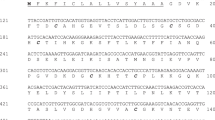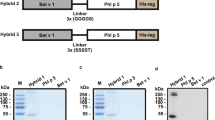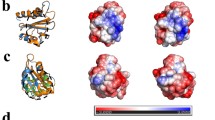Abstract
Successful research in the wide-ranging field of allergy is usually achieved by definition not only of physicochemical and immunological properties of natural, but also recombinant allergens. Blomia tropicalis mite is a well-known source for various groups of hypersensitivity-causing proteins. The goal of the present work was to produce, purify and characterise by in silico, biochemical and immunological methods the recombinant group-12 allergen of B. tropicalis. The recombinant Blo t 12 aggregation capacity as well as the affinity to antibodies from BALB/c immunised mice and B. tropicalis-sensitised human donors were investigated through in silico analyses, dynamic light scattering, SDS-PAGE, ELISA and Western blot. The presence of Blo t 12 within B. tropicalis extracts was also determined by ELISA and Western blot. High concentrations of dimeric rBlo t 12 were detected through SDS-PAGE next to other aggregates and the results were confirmed by data from DLS and Western blot. The YITVM peptide was predicted to be the most aggregation-prone region. The IgE-reactivity of rBlo t 12 was not completely abolished by aggregate formation but it was significantly decreased compared to rBlo t 5, or B. tropicalis extracts. Natural Blo t 12 may naturally dimerises, but it was detected in non-delipidified B. tropicalis extracts in low amounts. Given that this allergen may be a specific marker for B. tropicalis allergy, the recombinant Blo t 12 herein obtained is characterised as a mid-tier allergen in Brazilian atopic patients and may be useful for the improvement in precision allergy molecular diagnostic applications.





Similar content being viewed by others
References
Pawankar R (2014) Allergic diseases and asthma: a global public health concern and a call to action. World Allergy Organ J 7(1):12. https://doi.org/10.1186/1939-4551-7-12
Enilari O, Sinha S (2019) The global impact of asthma in adult populations. Ann Glob Health. https://doi.org/10.5334/aogh.2412
Miller JD (2019) The role of dust mites in allergy. Clin Rev Allergy Immunol 57(3):312–329. https://doi.org/10.1007/s12016-018-8693-0
Silva ESD, Pinheiro CS, Pacheco LGC, Alcantara-Neves NM (2020) Dermatophagoides spp. hypoallergens design: what has been achieved so far? Expert Opin Ther Pat 30(3):163–177. https://doi.org/10.1080/13543776.2020.1712360
Caraballo L, Valenta R, Acevedo N, Zakzuk J (2021) Are the terms major and minor allergens useful for precision allergology? Front Immunol. https://doi.org/10.3389/fimmu.2021.651500
Gonzalez-Perez R, Pineda F, Poza-Guedes P, Matheu V, Sanchez-Machin I (2018) Minor allergens in moderate-severe allergic rhinitis: group 4 mite amylasa (Blo t4) and geographical variations. J Allergy Clin Immunol 141(2):AB286. https://doi.org/10.1016/j.jaci.2017.12.911
Smole U, Gour N, Phelan J, Hofer G, Kohler C, Kratzer B, Tauber PA, Xiao X, Yao N, Dvorak J, Caraballo L, Puerta L, Rosskopf S, Chakir J, Malle E, Lane AP, Pickl WF, Lajoie S, Wills-Karp M (2020) Serum amyloid A is a soluble pattern recognition receptor that drives type 2 immunity. Nat Immunol 21(7):756–765. https://doi.org/10.1038/s41590-020-0698-1
Caraballo L, Zakzuk J, Lee BW, Acevedo N, Soh JY, Sanchez-Borges M, Hossny E, Garcia E, Rosario N, Ansotegui I, Puerta L, Sanchez J, Cardona V (2016) Particularities of allergy in the Tropics. World Allergy Organ J 9:20. https://doi.org/10.1186/s40413-016-0110-7
Santos da Silva E, Asam C, Lackner P, Hofer H, Wallner M, Silva Pinheiro C, Alcantara-Neves NM, Ferreira F (2017) Allergens of Blomia tropicalis: an overview of recombinant molecules. Int Arch Allergy Immunol 172(4):203–214. https://doi.org/10.1159/000464325
Soongrung T, Mongkorntanyatip K, Peepim T, Buaklin A, Le Mignon M, Malainual N, Nony E, Jacquet A (2018) The Blomia tropicalis allergen Blo t 7 stimulates innate immune signalling pathways through TLR2. Clin Exp Allergy 48(4):464–474. https://doi.org/10.1111/cea.13098
Carvalho KA, de Melo-Neto OP, Magalhaes FB, Ponte JC, Felipe FA, dos Santos MC, dos Santos LG, Cruz AA, Pinheiro CS, Pontes-de-Carvalho LC, Alcantara-Neves NM (2013) Blomia tropicalis Blo t 5 and Blo t 21 recombinant allergens might confer higher specificity to serodiagnostic assays than whole mite extract. BMC Immunol 14:11. https://doi.org/10.1186/1471-2172-14-11
Munera M, Martinez D, Labrada A, Caraballo L, Puerta L (2019) Identification of B cell epitopes of Blo t 13 allergen and cross-reactivity with human adipocytes and heart fatty acid binding proteins. Int J Mol Sci. https://doi.org/10.3390/ijms20246107
Acevedo N, Mohr J, Zakzuk J, Samonig M, Briza P, Erler A, Pomes A, Huber CG, Ferreira F, Caraballo L (2013) Proteomic and immunochemical characterization of glutathione transferase as a new allergen of the nematode Ascaris lumbricoides. PLoS One 8(11):e78353. https://doi.org/10.1371/journal.pone.0078353
Reginald K, Pang SL, Chew FT (2019) Blo t 2: Group 2 allergen from the dust mite Blomia tropicalis. Sci Rep 9(1):12239. https://doi.org/10.1038/s41598-019-48688-y
Zakzuk J, Jimenez S, Cheong N, Puerta L, Lee BW, Chua KY, Caraballo L (2009) Immunological characterization of a Blo t 12 isoallergen: identification of immunoglobulin E epitopes. Clin Exp Allergy 39(4):608–616. https://doi.org/10.1111/j.1365-2222.2008.03193.x
Fernandez-Caldas E, Puerta L, Caraballo L, Iraola V, Lockey R (2020) Mite allergens. In: Lockey RF, Ledford DK (eds) Allergens and allergen immunotherapy, 6th edn. CRC Press, FL USA, pp 213–235
Shek LP, Chong AR, Soh SE, Cheong N, Teo AS, Yi FC, Giam YC, Chua KY, Van Bever HP (2010) Specific profiles of house dust mite sensitization in children with asthma and in children with eczema. Pediatr Allergy Immunol 21(4 Pt 2):e718-722. https://doi.org/10.1111/j.1399-3038.2010.01019.x
Zakzuk J, Benedetti I, Fernandez-Caldas E, Caraballo L (2014) The influence of chitin on the immune response to the house dust mite allergen Blo T 12. Int Arch Allergy Immunol 163(2):119–129. https://doi.org/10.1159/000356482
Zambrano R, Jamroz M, Szczasiuk A, Pujols J, Kmiecik S, Ventura S (2015) AGGRESCAN3D (A3D): server for prediction of aggregation properties of protein structures. Nucleic Acids Res 43(W1):W306-313. https://doi.org/10.1093/nar/gkv359
Walsh I, Seno F, Tosatto SC, Trovato A (2014) PASTA 2.0: an improved server for protein aggregation prediction. Nucleic Acids Res. https://doi.org/10.1093/nar/gku399
Naik MT, Kung CCH, Huang T (2014) NMR solution structure of chitin-binding domain from dust mite group XII allergen Blo t 12. doi:https://doi.org/10.2210/pdb2MFK/pdb
da Silva ES, Huber S, Alcantara-Neves NM, Asam C, Silveira EF, de Andrade Belitardo EMM, Aglas L, Wallner M, Gadermaier G, Briza P, Karner I, Torres RT, Alvarez JRU, Wuenschmann S, Chapman M, Ferreira F, Pinheiro CS (2020) N-terminal peptide deletion influences immunological and structural features of Blo t 5. Allergy 75(6):1503–1507. https://doi.org/10.1111/all.14176
Santos da Silva E, Marques Ponte JC, Barbosa da Silva M, Silva Pinheiro C, Carvalho Pacheco LG, Ferreira F, Briza P, Alcantara-Neves NM (2019) Proteomic analysis reveals allergen variability among breeds of the dust mite blomia tropicalis. Int Arch Allergy Immunol 180(3):159–172. https://doi.org/10.1159/000501964
Pang KA, Pang KP, Pang EB, Tan YN, Chan YH, Siow JK (2017) Food allergy and allergic rhinitis in 435 asian patients – a descriptive review. Med J Malaysia 72(4):215–220
Rosano GL, Ceccarelli EA (2014) Recombinant protein expression in Escherichia coli: advances and challenges. Front Microbiol 5:172. https://doi.org/10.3389/fmicb.2014.00172
Zakzuk J (2012) Immunological and biological characterization of Blomia tropicalis allergens. University of Cartagena Cartagena, Colombia
Rodriguez-Bolanos M, Miranda-Astudillo H, Perez-Castaneda E, Gonzalez-Halphen D, Perez-Montfort R (2020) Native aggregation is a common feature among triosephosphate isomerases of different species. Sci Rep 10(1):1338. https://doi.org/10.1038/s41598-020-58272-4
Ferrari E, Corsini R, Burastero SE, Tanfani F, Spisni A (2020) The allergen Mus m 1.0102: cysteine residues and molecular allergology. Mol Immunol 120:1–12. https://doi.org/10.1016/j.molimm.2020.01.022
Najafi N, Hofer G, Gattinger P, Smiljkovic D, Blatt K, Selb R, Stoecklinger A, Keller W, Valent P, Niederberger V, Thalhamer J, Valenta R, Flicker S (2019) Fusion proteins consisting of Bet v 1 and Phl p 5 form IgE-reactive aggregates with reduced allergenic activity. Sci Rep 9(1):4006. https://doi.org/10.1038/s41598-019-39798-8
Golub N, Meremyanin A, Markossian K, Eronina T, Chebotareva N, Asryants R, Muronets V, Kurganov B (2007) Evidence for the formation of start aggregates as an initial stage of protein aggregation. FEBS Lett 581(22):4223–4227. https://doi.org/10.1016/j.febslet.2007.07.066
Weghofer M, Dall’Antonia Y, Grote M, Stocklinger A, Kneidinger M, Balic N, Krauth MT, Fernandez-Caldas E, Thomas WR, van Hage M, Vieths S, Spitzauer S, Horak F, Svergun DI, Konarev PV, Valent P, Thalhamer J, Keller W, Valenta R, Vrtala S (2008) Characterization of Der p 21, a new important allergen derived from the gut of house dust mites. Allergy 63(6):758–767. https://doi.org/10.1111/j.1398-9995.2008.01647.x
Mueller GA, Gosavi RA, Krahn JM, Edwards LL, Cuneo MJ, Glesner J, Pomes A, Chapman MD, London RE, Pedersen LC (2010) Der p 5 crystal structure provides insight into the group 5 dust mite allergens. J Biol Chem 285(33):25394–25401. https://doi.org/10.1074/jbc.M110.128306
Khemili S, Kwasigroch JM, Hamadouche T, Gilis D (2012) Modelling and bioinformatics analysis of the dimeric structure of house dust mite allergens from families 5 and 21: Der f 5 could dimerize as Der p 5. J Biomol Struct Dyn 29(4):663–675. https://doi.org/10.1080/073911012010525018
Pang SL, Ho KL, Waterman J, Rambo RP, Teh AH, Mathavan I, Harris G, Beis K, Say YH, Anusha MS, Sio YY, Chew FT, Ng CL (2019) Crystal structure and epitope analysis of house dust mite allergen Der f 21. Sci Rep 9(1):4933. https://doi.org/10.1038/s41598-019-40879-x
da Silva ES, Aglas L, Pinheiro CS, de Andrade Belitardo EMM, Silveira EF, Huber S, Torres RT, Wallner M, Briza P, Lackner P, Laimer J, Pacheco LGC, Cruz AA, Alcantara-Neves NM, Ferreira F (2020) A hybrid of two major Blomia tropicalis allergens as an allergy vaccine candidate. Clin Exp Allergy 50(7):835–847. https://doi.org/10.1111/cea.13611
Lahiani S, Dumez ME, Khemili S, Bitam I, Gilis D, Galleni M (2019) Cross-Reactivity between Major IgE Epitopes of Family 5 Allergens from Dermatophagoides pteronyssinus and Blomia tropicalis. Int Arch Allergy Immunol 178(1):10–18. https://doi.org/10.1159/000492871
Zaborsky N, Brunner M, Wallner M, Himly M, Karl T, Schwarzenbacher R, Ferreira F, Achatz G (2010) Antigen aggregation decides the fate of the allergic immune response. J Immunol 184(2):725–735. https://doi.org/10.4049/jimmunol.0902080
Shah K, Maghsoudlou P (2016) Enzyme-linked immunosorbent assay (ELISA): the basics. Br J Hosp Med (Lond) 77(7):C98-101. https://doi.org/10.12968/hmed.2016.77.7.C98
Pinheiro CS, Silva ES, de Andrade Belitardo EMM, Pacheco LGC, Aguiar ERGR, Alcantara-Neves NM, Gadermaier G, Ferreira F (2021) En route to personalized medicine: uncovering distinct IgE reactivity pattern to house dust mite components in Brazilian and Austrian allergic patients. Clin Trans Allergy. https://doi.org/10.1002/clt2.12004
Steering Committee A, Review Panel M (2020) A WAO - ARIA - GA(2)LEN consensus document on molecular-based allergy diagnosis (PAMD@): update 2020. World Allergy Organ J 13(2):100091. https://doi.org/10.1016/j.waojou.2019.100091
Casset A, Mari A, Purohit A, Resch Y, Weghofer M, Ferrara R, Thomas WR, Alessandri C, Chen KW, de Blay F, Valenta R, Vrtala S (2012) Varying allergen composition and content affects the in vivo allergenic activity of commercial Dermatophagoides pteronyssinus extracts. Int Arch Allergy Immunol 159(3):253–262. https://doi.org/10.1159/000337654
Alcantara-Neves NM, Veiga RV, Ponte JC, da Cunha SS, Simoes SM, Cruz AA, Yazdanbakhsh M, Matos SM, Silva TM, Figueiredo CA, Pontes-de-Carvalho LC, Rodrigues LC, Fiaccone RL, Cooper PJ, Barreto ML (2017) Dissociation between skin test reactivity and anti-aeroallergen IgE: determinants among urban Brazilian children. PLoS One 12(3):e0174089. https://doi.org/10.1371/journal.pone.0174089
Chandra S, Gray J, Kiosses WB, Khurana A, Hitomi K, Crosby CM, Chawla A, Fu Z, Zhao M, Veerapen N, Richardson SK, Porcelli SA, Besra G, Howell AR, Sharma S, Peters B, Kronenberg M (2018) Mrp1 is involved in lipid presentation and iNKT cell activation by Streptococcus pneumoniae. Nat Commun 9(1):4279. https://doi.org/10.1038/s41467-018-06646-8
Mindt BC, Fritz JH, Duerr CU (2018) Group 2 innate lymphoid cells in pulmonary immunity and tissue homeostasis. Front Immunol 9:840. https://doi.org/10.3389/fimmu.2018.00840
Iwamura C, Nakayama T (2018) Role of CD1d- and MR1-restricted T cells in asthma. Front Immunol 9:1942. https://doi.org/10.3389/fimmu.2018.01942
Doherty TA, Broide DH (2018) Lipid regulation of group 2 innate lymphoid cell function: Moving beyond epithelial cytokines. J Allergy Clin Immunol 141(5):1587–1589. https://doi.org/10.1016/j.jaci.2018.02.034
Acknowledgements
ESS was the recipient of a scholarship from the Research's Foundation of the State of Bahia (FAPESB grant BOL0449/2015). LGCP and NMAN are recipients of research fellowships from National Council for Scientific and Technological Development of Brazil (CNPq).
Funding
Coordination for the Improvement of Higher Education Personnel (CAPES), Project No. 077/2012.
Author information
Authors and Affiliations
Contributions
NM Alcantara-Neves designed the study and supervised the project. ES Silva significantly contributed to perform the present study, wrote the manuscript and conducted the in vitro and in vivo laboratory assays, as well as in silico analyses. CS Pinheiro co-supervised the project, helped with data analyses and manuscript revision. LGC Pacheco was involved in conception the project, revision/validation of in silico analysis assays and manuscript revision. AMS Fernandes performed IgE reactivity assay and helped with other experiments. C. Asam performed expression and purification pilot assays and manuscript revision. E.F. Silveira helped with laboratory assays, particularly DLS analyses. NM Alcantara-Neves and CS Pinheiro also drafted the manuscript. All authors read and approved the final manuscript.
Corresponding author
Ethics declarations
Conflict of interest
The authors have no conflicts of interest.
Ethical approval
Ethics Committee on Research of the Faculty of Medicine of the Federal University of Bahia (CAAE 45376814.0.0000.5577) approved human sera use. Ethical Committee for Use of Experimental Animals of the Institute of Health Sciences of Federal University of Bahia (CEUA-ICS 137/2018) allowed mice experiments
Additional information
Publisher's Note
Springer Nature remains neutral with regard to jurisdictional claims in published maps and institutional affiliations.
Supplementary Information
Below is the link to the electronic supplementary material.
11033_2021_6361_MOESM1_ESM.tif
Supplementary file1 — Fig. S1 Heterologous expressions and solubility test. Expression of rBlo t 12 in 5 mL of LB medium using BL21(DE3) (a), BL21(DE3)pLys S and TOP 10 F’ strains (b). c Western blot for confirmation of expression, using anti-HIS IgG antibodies. The sample added is indicated above each lane. MW: molecular weight. d 18% SDS-PAGE for the solubility test. e Western blot analysis of the same samples shown in d. Above each lane is indicated the sampleadded in the wells. Arrows indicate the suggestive band for rBlo t 12.(TIF 10854 kb)
11033_2021_6361_MOESM2_ESM.tif
Supplementary file2 — Fig. S2 PASTA 2.0 and AGGRESCAN3D analyses [19,20]. a Energy scores of the aggregation pairings retrieved from PASTA 2.0 server. b Aggregation free energy profile. c Aggregation helix profile from PASTA 2.0. d Ribbon representation of the aggregation-prone region, with the penultimate coil and β-sheet of Blo t 12. e Modelled 3D 10 structure retrieved from AGGRESCAN3D, focusing in the prone-aggregating region YITVM and other A3D scores residues (all in red). (TIF 7804 kb)
11033_2021_6361_MOESM3_ESM.tif
Supplementary file3 — Fig. S3 Correlations of sIgE binding assays. a Spearman’s correlation of BtE ELISA results and sIgE from ImmunoCAP assay (n=30). b Spearman’s correlation of rBlo t 5 ELISA results and sIgE from ImmunoCAP assay (n=25). (TIF 4361kb)
Rights and permissions
About this article
Cite this article
da Silva, E.S., Pacheco, L.G.C., Fernandes, A.M.S. et al. Purification and characterisation of the dimeric group 12 allergen from Blomia tropicalis heterologously expressed by Escherichia coli Top10F´. Mol Biol Rep 48, 3405–3416 (2021). https://doi.org/10.1007/s11033-021-06361-6
Received:
Accepted:
Published:
Issue Date:
DOI: https://doi.org/10.1007/s11033-021-06361-6




